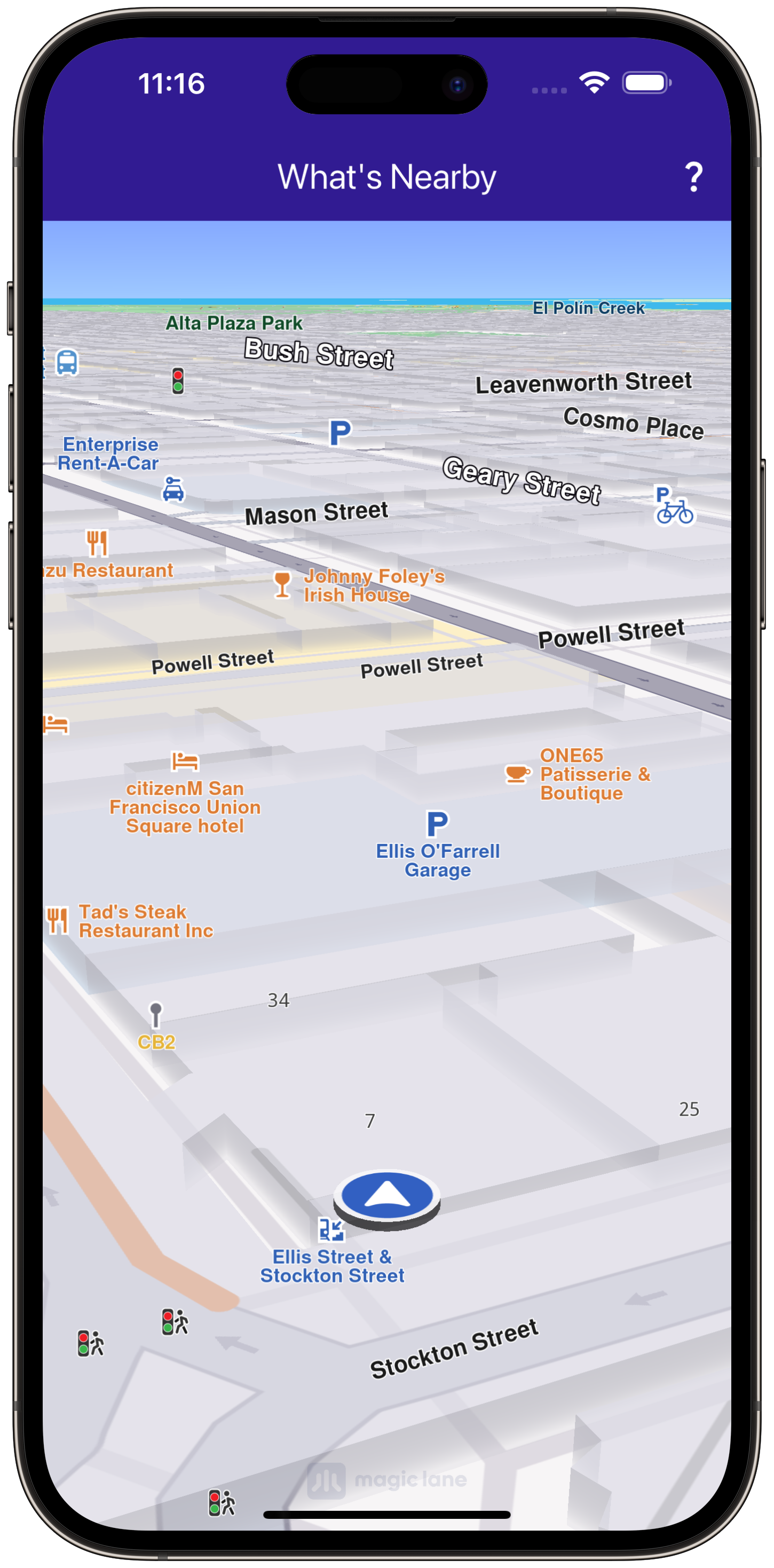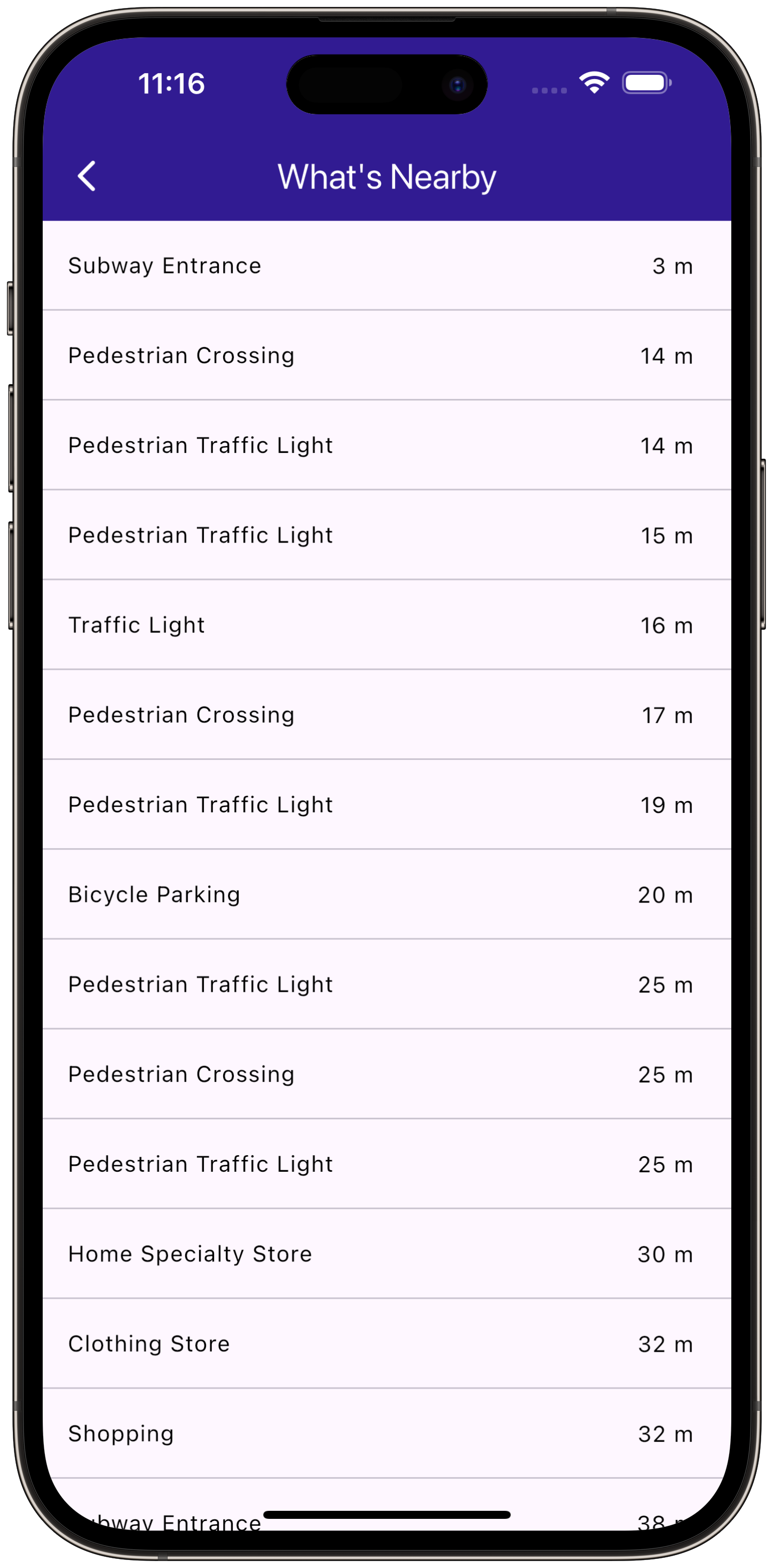What is Nearby¶
gem_kit package.
|
|||
Setup¶
Prerequisites¶
Build and Run¶
Navigate to the project folder for this example to build and run the application.
Note - the gem_kit directory containing the Maps SDK for Flutter
should be in the plugins directory of the example, e.g.
example_pathname/plugins/gem_kit - see the environment setup guide above.
Run: flutter pub get
Configure the native parts:
First, verify that the ANDROID_SDK_ROOT environment variable
is set to the root path of your android SDK.
In android/build.gradle add the maven block as shown,
within the allprojects block, for both debug and release builds:
allprojects {
repositories {
google()
mavenCentral()
maven {
url "${rootDir}/../plugins/gem_kit/android/build"
}
}
}
in android/app/build.gradle
within the android block, in the defaultConfig block,
the android SDK version minSdk must be set as shown below.
Additionally, for release builds, in android/app/build.gradle,
within the android block, add the buildTypes block as shown:
Replace example_pathname with the actual project pathname
android {
defaultConfig {
applicationId "com.magiclane.gem_kit.examples.example_pathname"
minSdk 21
targetSdk flutter.targetSdk
versionCode flutterVersionCode.toInteger()
versionName flutterVersionName
}
buildTypes {
release {
minifyEnabled false
shrinkResources false
// TODO: Add your own signing config for the release build.
// Signing with the debug keys for now, so `flutter run --release` works.
signingConfig signingConfigs.debug
}
}
}
Then run the project:
flutter run --debugorflutter run --release
App entry and initialization¶
const projectApiToken = String.fromEnvironment('GEM_TOKEN');
void main() {
runApp(const MyApp());
}
This code initializes the projectApiToken with the required authorization token and launches the app.
How It Works¶
This example app demonstrates the following features:
Obtain location permissions and show a map centered on the user’s location.
Display nearby landmarks as a list.
Allow navigation to a detail page displaying information about nearby landmarks.
|
|||
Map Display and Permissions¶
The map is displayed and initialized within the MyHomePage widget, which also handles location permissions for Android and iOS.
class MyHomePage extends StatefulWidget {
const MyHomePage({super.key});
@override
State<MyHomePage> createState() => _MyHomePageState();
}
class _MyHomePageState extends State<MyHomePage> {
late GemMapController _mapController;
PermissionStatus _locationPermissionStatus = PermissionStatus.denied;
bool _hasLiveDataSource = false;
@override
void dispose() {
GemKit.release();
super.dispose();
}
@override
Widget build(BuildContext context) {
return Scaffold(
appBar: AppBar(
backgroundColor: Colors.deepPurple[900],
title: const Text('What\'s Nearby', style: TextStyle(color: Colors.white)),
actions: [
IconButton(
onPressed: () => _onWhatIsNearbyButtonPressed(context),
icon: const Icon(Icons.question_mark, color: Colors.white),
),
],
),
body: GemMap(onMapCreated: _onMapCreated, appAuthorization: projectApiToken),
);
}
This widget handles the UI, setting up the map and app bar, and uses permission_handler for requesting location permissions.
Fetching Nearby Locations¶
The WhatIsNearbyPage widget displays a list of nearby landmarks based on the user’s current position.
class WhatIsNearbyPage extends StatefulWidget {
final Coordinates position;
const WhatIsNearbyPage({super.key, required this.position});
@override
State<WhatIsNearbyPage> createState() => _WhatIsNearbyPageState();
}
class _WhatIsNearbyPageState extends State<WhatIsNearbyPage> {
@override
Widget build(BuildContext context) {
return Scaffold(
appBar: AppBar(
title: const Text("What's Nearby", style: TextStyle(color: Colors.white)),
backgroundColor: Colors.deepPurple[900],
),
body: FutureBuilder(
future: _getNearbyLocations(),
builder: (context, snapshot) {
if (!snapshot.hasData) {
return const Center(child: CircularProgressIndicator());
}
return ListView.separated(
itemBuilder: (context, index) => NearbyItem(
landmark: snapshot.data![index],
currentPosition: widget.position,
),
separatorBuilder: (context, index) => const Divider(height: 0),
itemCount: snapshot.data!.length,
);
},
),
);
}
Future<List<Landmark>?> _getNearbyLocations() async {
final preferences = SearchPreferences(searchAddresses: false)
..landmarkCategories = GenericCategories.categories;
final completer = Completer<List<Landmark>?>();
SearchService.searchAroundPosition(preferences: preferences, widget.position, (err, result) {
completer.complete(result);
});
return completer.future;
}
This code searches for nearby landmarks, displaying the results in a ListView.
Displaying Landmark Information¶
Each nearby landmark is displayed in a list tile showing the name and distance from the current position.
class NearbyItem extends StatefulWidget {
final Landmark landmark;
final Coordinates currentPosition;
const NearbyItem({super.key, required this.landmark, required this.currentPosition});
@override
State<NearbyItem> createState() => _NearbyItemState();
}
class _NearbyItemState extends State<NearbyItem> {
@override
Widget build(BuildContext context) {
return ListTile(
title: Text(
widget.landmark.categories.first.name,
style: const TextStyle(fontSize: 14, fontWeight: FontWeight.w400),
maxLines: 2,
overflow: TextOverflow.ellipsis,
),
trailing: Text(
_convertDistance(widget.landmark.coordinates.distance(widget.currentPosition).toInt()),
style: const TextStyle(fontSize: 14, fontWeight: FontWeight.w400),
),
);
}
String _convertDistance(int meters) {
if (meters >= 1000) {
return '${(meters / 1000).toStringAsFixed(1)} km';
} else {
return '$meters m';
}
}
This component formats and displays the name and distance of each landmark.



